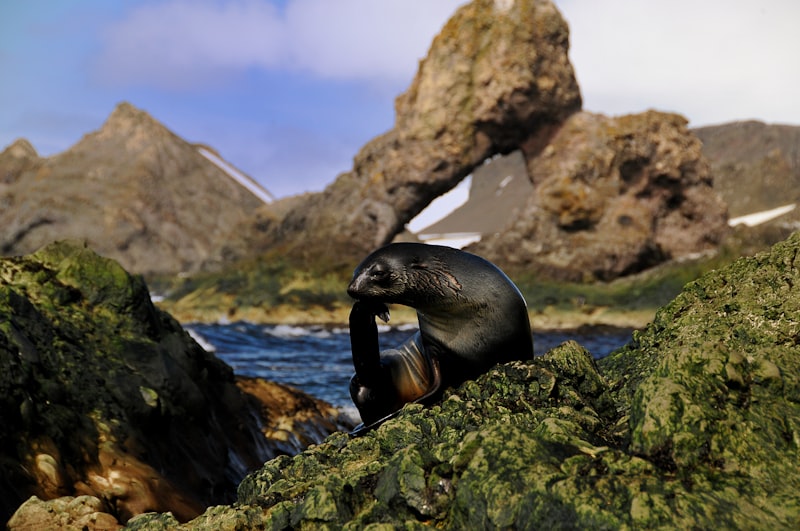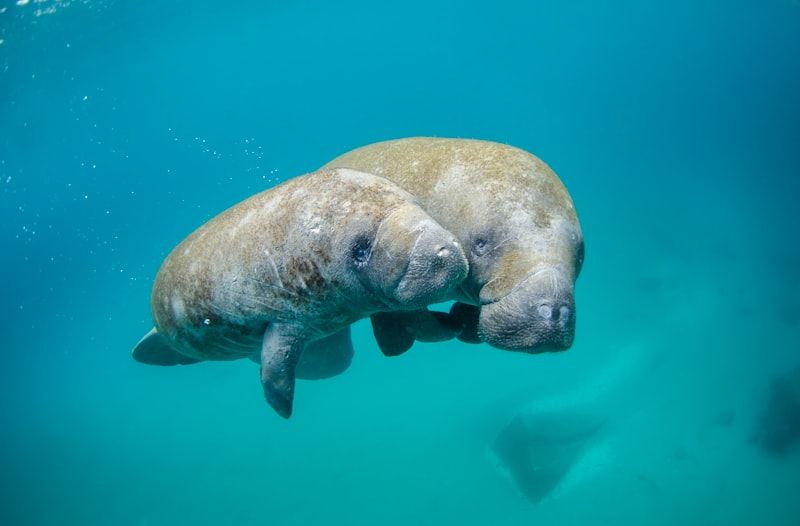Take for instance the humble but mighty coral reef builders. These tiny polyps collectively construct vast structures that provide shelter, food, and breeding grounds for countless fish, invertebrates, and other organisms. Their calcium carbonate skeletons form intricate reefs that buffer coastlines from waves and storms, supporting local economies through tourism and fisheries.
Similarly, kelp forests sway like underwater forests, nurtured by species like giant kelp. These towering algae provide food and shelter for numerous marine creatures, from tiny fish to sea otters. Their dense canopies reduce wave energy and act as carbon sinks, playing a vital role in mitigating climate change impacts.
On the seabed, burrowing species like the humble sea urchins and worms engineer sedimentary habitats. Their digging aerates the sediment, enhancing nutrient cycling and oxygen levels for other bottom-dwelling organisms. These actions create complex microhabitats where delicate species thrive, ensuring biodiversity in otherwise barren expanses.
Even the elusive mangrove trees, found at the interface of land and sea, engineer ecosystems crucial for coastal resilience. Their intricate root systems stabilize shorelines, trap sediments, and provide nurseries for juvenile fish. Mangroves protect coastal communities from storms and floods, acting as nature’s frontline defense against climate-induced disasters.
Nature’s Architects: How Marine Ecosystem Engineers Shape Ocean Habitats
Have you ever considered how the underwater world is meticulously crafted and shaped? Marine ecosystem engineers, often overlooked, play a crucial role in constructing and maintaining habitats beneath the ocean’s surface. These engineers are not equipped with tools and blueprints like human architects; instead, they are creatures like corals, kelp forests, and even certain species of fish and mollusks that alter their environment significantly.
Imagine a coral reef, a bustling city beneath the waves. Corals, tiny polyps that work collectively, build intricate calcium carbonate structures over centuries. These reefs provide shelter, food, and breeding grounds for countless marine species, from colorful fish to majestic sea turtles. They are not just beautiful; they are essential for the survival of marine life.
Similarly, kelp forests, towering underwater forests of giant kelp, are another example of nature’s architects. These fast-growing algae can reach heights of over a hundred feet, creating a three-dimensional habitat where fish can hide, feed, and reproduce. Kelp forests are not only productive ecosystems but also vital carbon sinks, absorbing carbon dioxide from the atmosphere and helping mitigate climate change.
Even seemingly small organisms like marine worms and mollusks play a part as ecosystem engineers. They burrow into the seabed, creating complex networks of tunnels that aerate the sediment and provide homes for other creatures. These activities promote biodiversity and enhance the overall health of the marine environment.
The impact of these marine architects extends beyond their immediate surroundings. For example, mangrove forests along coastlines act as natural buffers against storms, protecting coastal communities from erosion and flooding. They also serve as nurseries for fish and other marine species, supporting livelihoods and biodiversity.
Understanding the role of marine ecosystem engineers is crucial for conservation efforts. By protecting these natural architects and their habitats, we can ensure the resilience of marine ecosystems against threats like climate change, pollution, and overfishing. Next time you snorkel or dive into the ocean, take a moment to appreciate the intricate structures built by these incredible creatures and their profound impact on marine life.
Underwater Architects: The Role of Marine Ecosystem Engineering Species
Picture a bustling city where each species contributes uniquely to its infrastructure. In the ocean, marine ecosystem engineering species like corals, kelp forests, and mangroves are the master builders. They don’t just exist; they create entire habitats that support countless marine creatures.
Take corals, for instance. These tiny polyp colonies may seem insignificant individually, but together, they construct vast reefs that rival the complexity of human-made cities. Coral reefs provide homes for fish, protect coastlines from erosion, and even attract tourists eager to explore their vibrant beauty.
Moving to kelp forests, these towering underwater forests resemble our terrestrial counterparts, yet they thrive in the dynamic marine environment. Kelp species act as underwater skyscrapers, offering shelter to an array of marine life, from sea otters to small fish seeking refuge from predators.
On coastal edges, mangroves take the stage as nature’s coastal engineers. Their complex root systems stabilize shorelines and provide breeding grounds for numerous fish species. Mangroves also act as carbon sinks, helping mitigate climate change impacts by absorbing large amounts of atmospheric carbon dioxide.
These marine architects aren’t just passive residents; they actively modify their surroundings. By altering water flow, creating niches for other species, and influencing nutrient cycling, they shape entire ecosystems. Their work isn’t just beautiful; it’s essential for the health of our oceans.
Understanding the role of marine ecosystem engineering species isn’t just about appreciation; it’s about conservation. Human activities threaten these delicate underwater architects, from coral bleaching due to climate change to coastal development encroaching on mangrove habitats.
As we marvel at their underwater creations, we must also consider our impact on these fragile ecosystems. By protecting marine engineers like corals, kelp forests, and mangroves, we safeguard the biodiversity and resilience of our oceans for generations to come.
Building for Biodiversity: Impact of Marine Ecosystem Engineers on Ocean Life
Have you ever wondered about the architects of life beneath the ocean’s surface? Marine ecosystem engineers, like corals, oysters, and mangroves, play a pivotal role in shaping underwater habitats. These organisms aren’t just passive residents; they actively construct environments that support a dazzling array of marine life.
Take corals, for example. These remarkable creatures are not just beautiful reefs; they are essential architects of entire ecosystems. Coral reefs provide shelter and food for countless marine species, from colorful fish to microscopic plankton. Their calcium carbonate skeletons form the intricate structures that protect coastlines and nurture biodiversity.
Oysters, often overlooked, are marine engineers in their own right. They build reefs that provide nursery grounds for fish and help filter water, improving its quality. These reefs also stabilize sediment and protect shorelines from erosion, making them invaluable in coastal ecosystems.
Mangroves, found along tropical coastlines, create intricate root systems that serve as nurseries for juvenile fish and provide a buffer against storms. Their ability to thrive in brackish water makes them vital in protecting coastal communities and supporting diverse marine life.

What makes these ecosystem engineers truly remarkable is their ability to enhance biodiversity. By creating complex habitats, they foster a web of interdependencies among species, promoting resilience in the face of environmental changes. Their structures not only house marine life but also contribute to nutrient cycling and carbon sequestration, playing a crucial role in global climate regulation.
As we delve deeper into understanding these marine architects, we uncover a world where every structure, every organism, plays a part in sustaining life beneath the waves. Their impact reaches far beyond their physical presence, influencing everything from local fisheries to global climate patterns.
Guardians of Coral Reefs: Marine Ecosystem Engineers and Their Vital Role
Coral reefs are not just beautiful underwater structures; they are bustling hubs of biodiversity, offering shelter and sustenance to countless marine species. Imagine them as the architects of an underwater metropolis, where every structure serves a purpose. From the vibrant corals themselves to the myriad fish, mollusks, and crustaceans that call reefs home, each species plays a part in maintaining the delicate equilibrium.
At the heart of this bustling city are the coral polyps, tiny creatures that collectively build massive limestone structures over centuries. These structures provide habitats for fish and other marine organisms, offering protection from predators and serving as breeding grounds. The corals themselves rely on a symbiotic relationship with photosynthetic algae called zooxanthellae, which give them their vibrant colors and provide essential nutrients through photosynthesis.

But the role of marine ecosystem engineers extends beyond coral polyps. Various species of fish, such as parrotfish and surgeonfish, play crucial roles in maintaining reef health. Parrotfish, for instance, graze on algae that can otherwise suffocate corals, helping to keep the reef clean and healthy. In doing so, they prevent the overgrowth of algae that could otherwise compete with corals for space and resources.
Moreover, the complexity of these interactions underscores the resilience of coral reefs in the face of environmental challenges. Climate change, pollution, and overfishing threaten these delicate ecosystems, disrupting the balance carefully maintained by marine ecosystem engineers. As stewards of our oceans, it’s crucial to recognize the vital role these guardians play and work towards preserving their habitats for future generations.
The guardians of coral reefs exemplify nature’s intricate design and the interdependence of species within marine ecosystems. By understanding and protecting these ecosystem engineers, we can ensure the continued health and vitality of coral reefs worldwide.
From Seabed to Skyline: How Marine Species Engineer Their Environments
Take coral reefs, for instance. These intricate structures are built by tiny coral polyps, each no larger than a dime. Working together, they form colossal reefs that stretch for miles. Beyond their breathtaking beauty, coral reefs serve as crucial ecosystems, providing shelter and food for a quarter of all marine life. Their engineering prowess doesn’t stop there – they even protect coastlines from erosion and storm surges, acting as natural barriers against the fury of the sea.
Moving up the ladder of marine architects, we encounter the humble beaver. Yes, you read that right – the beaver is a marine engineer. Found in freshwater habitats, these industrious creatures build dams using logs, mud, and rocks. Their constructions create ponds that benefit entire ecosystems, supporting a diverse array of plants and animals. By altering water flow, beavers also play a vital role in maintaining water quality and regulating flooding.
But it’s not just about structures; some marine species alter their environments through sheer force of will. Consider the humble sea urchin. Despite their spiny appearance, these creatures play a crucial role in maintaining the health of coral reefs. By grazing on algae, sea urchins prevent it from smothering coral and allow new coral polyps to settle and grow.
And let’s not forget the astonishing architects of the deep sea – giant tube worms. These remarkable creatures thrive near hydrothermal vents, where scorching hot water gushes from beneath the Earth’s crust. Tube worms host bacteria in their bodies that convert chemicals from the vent fluids into energy – a process known as chemosynthesis. In doing so, they not only survive in extreme conditions but also support entire ecosystems in the abyssal depths.
Frequently Asked Questions
How do human activities impact marine ecosystem engineering species?
Learn how human activities affect marine ecosystem engineering species, influencing their habitats and ecological roles.
What are examples of prominent marine ecosystem engineers?
Learn about significant marine ecosystem engineers, including species like coral reefs, mangroves, and kelp forests. These organisms play crucial roles in shaping their environments, providing habitats, and supporting biodiversity.
What are marine ecosystem engineering species?
Learn about marine ecosystem engineering species, organisms that significantly modify their environment, shaping habitats for themselves and other species. Explore how these species contribute to biodiversity and ecosystem health in oceans and coastal areas.
How do ecosystem engineering species shape marine habitats?
Learn how ecosystem engineering species play a pivotal role in shaping marine habitats through their transformative actions, altering physical structures and ecological dynamics to support diverse marine life.
Why are marine ecosystem engineers crucial for biodiversity?
Marine ecosystem engineers are crucial for biodiversity because they create, modify, and maintain habitats that support a wide variety of species. By shaping their environments, these organisms enhance ecological diversity, promote species richness, and contribute to the overall stability of marine ecosystems.


